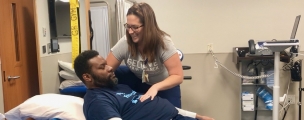Yesterday, I took my kids on our annual shopping extravaganza for back to school supplies. It’s a challenge between my nine-year-old son who claims he doesn’t really need anything and my middle school aged daughter who needs EVERYTHING. Nevertheless, once we managed to find everything on the school lists, we came home with enough stuff to fill five backpacks. Good grief.
Backpacks continue to be a staple school supply for kids, and nowadays, more and more adults are sporting them as well to tote stuff to and from work. Just because so many people use them, however, does not mean they’re using them in a way that makes them any safer than a large duffle bag slung over one shoulder. In fact, often times they’re not.
Injuries from carrying school or office supplies improperly are common but don’t usually happen in a single instance. Neck, back and shoulder pain creep up over time. When problems do surface, discomfort in any of these areas can easily interfere with school, work and other athletic endeavors, and should not be taken lightly. Though schools are steadily making changes to limit the amount of stuff children have to carry, kids are often still hauling heavy loads that exceed recommended standards.
So what safety tips are recommended? Here are several:
Lessen the load. The backpack should contain no more than 10-15% of the child’s body weight. That means a 100 pound child should be carrying no more than 10-15 pounds in their back pack… a 50 pound child, no more than 5-7 pounds. Do a test at the start of the school year and see if they’re meeting that mark.
Wear it right. Perhaps even more important than what is in the backpack, is its position when worn. The backpack should rest over the strong muscles of the mid-back so they can provide the most support. To achieve this, both straps should be evenly adjusted so the back pack hangs evenly and the straps should be at a length that assures the bottom of the backpack does not extend past the low back.
Get the right type. The right type may not be the most fashionable, but there are some pretty snazzy AND safe options out there nowadays. Well-padded shoulder straps are a must to limit pinching vessels and nerves in the shoulder and neck region. It should also have at least a couple compartments to minimize larger heavier items shifting around inside.
Fill it sensibly. Organize items so that heavier textbooks or other items are closest to the body and smaller lighter items are in the outer compartments. Arrange books and materials so they don’t slide around within the pack.
Plan ahead. This one is hard for kids (and some adults), but in the middle school years especially, when most kids start moving around between many classrooms, help them come up with a plan for what they need when so they’re not toting everything around all day.
Clean out the back pack regularly. If your kids are like mine, this needs to be a supervised activity; otherwise, by winter break, half the load is stuff that does not need to be in there anymore.
Typically, it takes a few reminders and perhaps some consistent nagging before the above suggestions become habit, but after getting used to wearing a back pack properly, most will feel uncomfortable wearing it any other way. If pain does arise, consult a physician and ask to see a physical therapist. With early intervention, the source of the pain can usually be identified and eliminated quickly before bigger problems that are harder to resolve creep up.
Wishing all of our youngsters a safe and successful school year!
Magee offers physical therapy at three outpatient sites throughout the Philadelphia region. To learn more, click here.
Editor’s Note: This blog was originally published in September 2014 and was reviewed for accuracy and clarity in September 2018.







